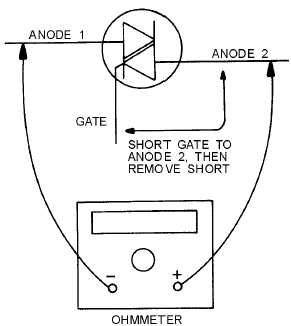2-22
Q-15.
When testing an SCR with an ohmmeter, the SCR will conduct if what two elements are shorted
together?
TRIAC
Triac is General Electric’s trade name for a silicon, gate-controlled, full-wave, ac switch, as shown in
figure 2-13. The device is designed to switch from a blocking state to a conducting state for either polarity
of applied voltages and with either positive or negative gate triggering. Like a conventional SCR, the
Triac is an excellent solid-state device for controlling current flow. You can make the Triac conduct by
using the same method used for an SCR, but the Triac has the advantage of being able to conduct equally
well in either the forward or reverse direction.
Figure 2-13.—Testing a Triac with an ohmmeter.
To test the Triac with an ohmmeter (R 1 scale), you connect the ohmmeter’s negative lead to anode
1 and the positive lead to anode 2, as shown in figure 2-13. The ohmmeter should indicate a very high
resistance. Short the gate to anode 2; then remove it. The resistance reading should drop to a low value
and remain low until either of the ohmmeter leads is disconnected from the Triac. This completes the first
test.
The second test involves reversing the ohmmeter leads between anodes 1 and 2 so that the positive
lead is connected to anode 1 and the negative lead is connected to anode 2. Again, short the gate to anode
2; then remove it. The resistance reading should again drop to a low value and remain low until either of
the ohmmeter leads is disconnected.
Q-16.
When a Triac is properly gated, what is/are the direction(s) of current flow between anodes 1
and 2?
UNIJUNCTION TRANSISTORS (UJTs)
The unijunction transistor (UJT), shown in figure 2-14, is a solid-state, three-terminal semiconductor
that exhibits stable open-circuit, negative-resistance characteristics. These characteristics enable the UJT

